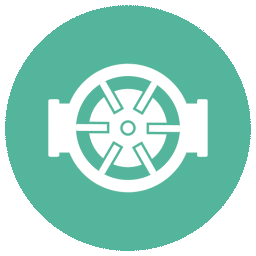How does a Rotary Vane Pump work?
Standard rotary vane pumps operate on the principle of the eccentricity between the shaft and the pump casing bore (stator). Rotary vane pumps come in two types: the flexible vane and sliding vane.


Flexible vane pumps
In flexible vane pumps the vanes are made from a malleable material. The tips of the vanes used in flexible vane pump are lobe shaped and when rotating they flex in order to maintain contact with the walls of the stator, thereby trapping the fluid in small pockets or cavities. When the discharge pipe is reached the trapped fluid is released from the pockets.
Sliding vane pumps
In sliding vane pumps, the vanes are made from a rigid material and do not flex when rotating. The rigid vanes that are free to slide into or out of slots in the pump rotor by way of springs or pressure-activated pins in the rotor. As the rotor turns, the vanes move out of the rotor slots creating a void at the inlet port and drawing fluid in. The fluid is transferred from the inlet port to the discharge port between the vanes. At the outlet, the fluid is discharged and the pumping chamber is reduced and the vanes slide back into the rotor slots.
What are the benefits of Rotary Vane Pumps?
Rotary vane pumps deliver a gentle low shear action so that the structure of the pumped fluid is not affected.
By virtue of their inherent energy and mechanically efficient designs, positive displacement rotary and sliding vane pumps are perfectly suited to offering operators immediate high value advantages and solutions in fulfilling their energy saving initiatives. In reviewing a list of the most common system characteristics that need to be considered in pumping applications, positive displacement pumps outperform centrifugal pumps in almost all of them.
Depending on the technology chosen, rotary vane pumps may offer:
- Ability to self-prime.
- Constant flow that is relatively independent of changes in system pressure.
- Constant flow that is relatively independent of changes in viscosity.
- Ability to handle medium and low viscosity products.
- Can handle thin liquids at relatively higher pressures.
- Develop a good vacuum.
- Ability to run dry for short periods.
- Higher efficiency across varying system pressures.
Where can Rotary Vane Pumps be used?
Rotary vane pumps are used in many different applications due to their all-round versatility. Typical applications include fluids that display varying levels of viscosity, have high or low temperature levels, are non-lubricating or could be made from ingredients that can be aggressive and cause damage to the pump.
When it comes to light, non-lubricating fluids such as alcohols and solvents then vane pumps are very often the best solution as they are self-lubricating and can (with the correct design) cope with low net positive suction head (NPSH).
How to select the right Rotary Vane Pump?
When it comes to selecting a pumping system, the choice commonly comes down to rotary positive displacement and centrifugal types, as both types can often be used for the same applications.
If you have a relatively low flow and a relatively high-pressure requirement, or if you require the pump to be self-priming, then a vane pump will often be the best solution.
When selecting a rotary vane pump you should, among other things, consider whether it should be:
- Using alternating or direct current
- Oil-sealed or dry
Do you need help choosing the right pump for your industry and needs? Get in touch, our team of knowledgeable experts would be happy to advise you!









